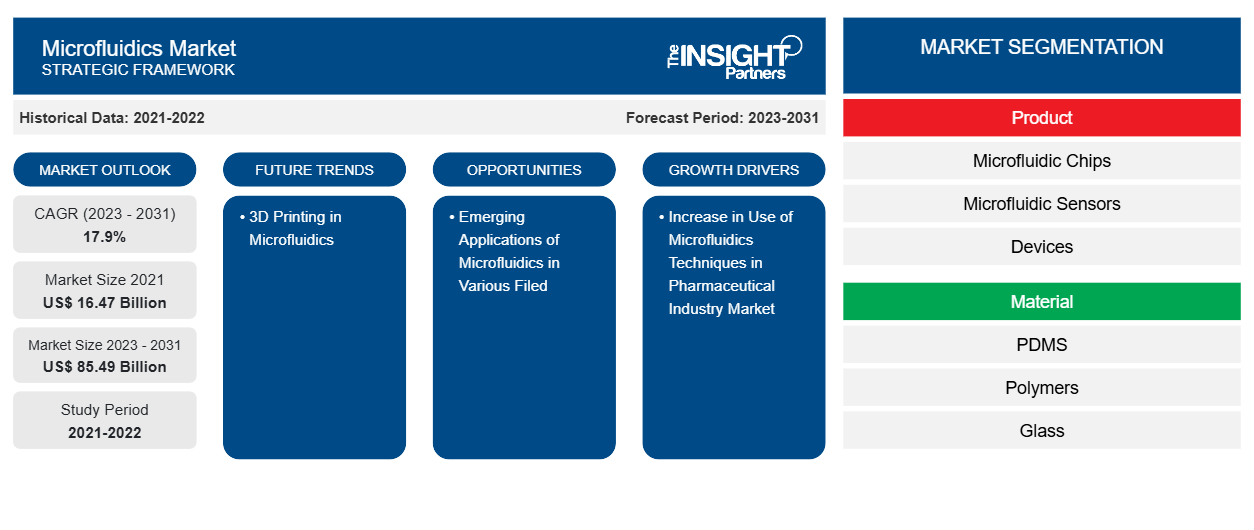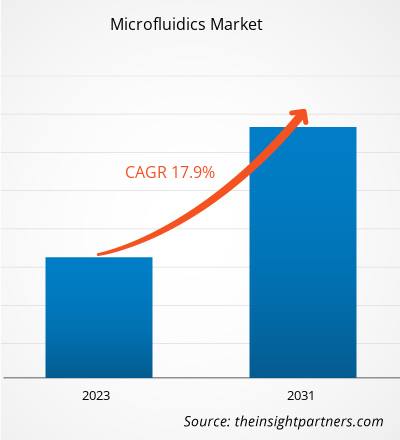The microfluidics market was valued at US$ 16.47 billion in 2021 and is expected to reach US$ 85.49 billion by 2031. The market is expected to register a CAGR of 17.9% in 2023–2031. 3D printing in microfluidics will likely remain a key market trend.
Microfluidics Market Analysis
The microfluidics market is expanding quickly due to biotechnology, medicine, and healthcare applications. Miniaturization, automation, and high throughput capabilities are important components. Players in the market include established businesses and start-ups pioneering in fields like point-of-care testing, drug delivery, and diagnostics. North America and Europe are the leading regions because of their strong investment in and infrastructure for research. Integration for improved functionality and efficiency with other technologies, such as AI and IoT, is one of the emerging trends in the market.
Microfluidics Market Overview
Microfluidics encompasses two fields of study: the science of fluid behavior in micro-channels and the technology of producing microminiaturized devices with tunnels and chambers for fluid flow or confinement. The field of microfluidics deals with fluid volumes as small as femtoliters (fL), or a quadrillionth of a liter. On the micrometric scale, fluids behave very differently from their real-world counterparts. These peculiarities are crucial for new scientific discoveries and experiments. These days, microfluidics offers effective instruments for various fields of study, particularly biological analysis. Complete biological process streamlined and integrated for end users, assays with high throughput, multiplexing, and high parallelization quicker analyses because of the shortened times for reactions and separation, portable tools for use in point-of-care settings, minimal reagent usage, reduction of global costs per analysis, microfluidics enables precise measurement. It raises the measurement resolution in specific applications, etc., which are benefits offered by microfluidics. This may lead to rising demand for microfluidics, boosting market growth.
Customize This Report To Suit Your Requirement
You will get customization on any report - free of charge - including parts of this report, or country-level analysis, Excel Data pack, as well as avail great offers and discounts for start-ups & universities
Microfluidics Market: Strategic Insights

-
Get Top Key Market Trends of this report.This FREE sample will include data analysis, ranging from market trends to estimates and forecasts.
Microfluidics Market Drivers and Opportunities
Increase in Use of Microfluidics Techniques in Pharmaceutical Industry Market
The pharmaceutical industry has incorporated numerous microfluidic processes in personalized medicine to find and deliver novel medications. Microfluidic devices can accelerate numerous stages of the process, such as target selection, clinical trials, chemical synthesis, formulations studies, and product management. Given the high expense of drug R&D, these developments might eventually help consumers and drive market growth.
Emerging Applications of Microfluidics in Various Filed – An Opportunity in Microfluidics Market
In academic research, microfluidics continues to be an interdisciplinary field where engineers and cell biologists collaborate. The goal of these partnerships is to improve cell culture experimentation continuously. Conversely, the biomedical sector is only now beginning to leverage microfluidics to a great extent. Microfluidic devices have been used in several significant recent advancements in the study and creation of novel therapeutic drugs and medical diagnostics. For a straightforward blood test, for instance, employing a microfluidic device requires less blood and significantly speeds up processing times. Research and development teams are also using microfluidic techniques to test new medications. Thus, an increase in the application of microfluidics techniques will likely create ample opportunities in the market.
Microfluidics Market Report Segmentation Analysis
Key segments contributing to the Microfluidics market analysis derivation are product, technology, material, and application.
- Based on therapy type, the product market is divided into microfluidic chips, microfluidic sensors, devices, micropumps, microneedles, other products. The devices segment held a larger market share in 2023.
- By material, the market is segmented into PDMS, polymers, glass, silicon, other materials. The PDMS segment held the largest share of the market in 2023.
- By application, the market is segmented into in vitro diagnostics, pharmaceutical and life science research, drug discovery, other applications. The in vitro diagnostics segment held the largest share of the market in 2023.
Microfluidics Market Share Analysis by Geography
The microfluidics market report's geographic scope is divided into five regions: North America, Asia Pacific, Europe, Middle East & Africa, and South America/South & Central America.
North America has dominated the microfluidics market. In North America, the U.S. is the largest market for microfluidics in 2023. The market in the region is preliminary driven by an increase in research and development activities, early adoption of technological advancement, and significant investment by key players. For instance, in May 2021, nuclear, a rapidly expanding biotech business that is creating enzymatic protein and gene synthesis technologies, and E Ink, the industry pioneer in electronic ink technology, announced that E Ink's digital microfluidics unit has been acquired by Nuclera, a newly established US subsidiary.
Microfluidics Market Regional InsightsThe regional trends and factors influencing the Microfluidics Market throughout the forecast period have been thoroughly explained by the analysts at The Insight Partners. This section also discusses Microfluidics Market segments and geography across North America, Europe, Asia Pacific, Middle East and Africa, and South and Central America.
Microfluidics Market Report Scope
| Report Attribute | Details |
|---|---|
| Market size in 2021 | US$ 16.47 Billion |
| Market Size by 2031 | US$ 85.49 Billion |
| Global CAGR (2023 - 2031) | 17.9% |
| Historical Data | 2021-2022 |
| Forecast period | 2023-2031 |
| Segments Covered |
By Product
|
| Regions and Countries Covered |
North America
|
| Market leaders and key company profiles |
|
Microfluidics Market Players Density: Understanding Its Impact on Business Dynamics
The Microfluidics Market is growing rapidly, driven by increasing end-user demand due to factors such as evolving consumer preferences, technological advancements, and greater awareness of the product's benefits. As demand rises, businesses are expanding their offerings, innovating to meet consumer needs, and capitalizing on emerging trends, which further fuels market growth.

- Get the Microfluidics Market top key players overview
Microfluidics Market News and Recent Developments
The microfluidics market is evaluated by gathering qualitative and quantitative data post primary and secondary research, which includes important corporate publications, association data, and databases. The following is a list of developments in the market for microfluidics and strategies:
- CellFE Inc., an innovative microfluidics company dedicated to transforming the development and manufacture of advanced cell therapies, announced the commercial availability of its Infinity Mtx cellular engineering platform, which uses rapid cell compression and re-expansion to actively transport a target payload into the cell. The benefits of CellFE's microfluidic cellular engineering platform include high yields of edited cells, reduced cell recovery and expansion times, and efficient uptake of diverse payloads, translating to shorter vein-to-vein times and lower manufacturing costs. (Source: CellFE Inc Company Name, Press Release, 2023)
- TE Connectivity, a world leader in connectors and sensors, has acquired three companies focused on microfluidic cartridge and blister reagent package development, usability testing, clinical research and manufacturing. (Source: TE Connectivity Company Name, Newsletter, 2021)
Microfluidics Market Report Coverage and Deliverables
The “Microfluidics Market Size and Forecast (2021–2031)” report provides a detailed analysis of the market covering below areas:
- Market size and forecast at global, regional, and country levels for all the key market segments covered under the scope
- Market dynamics such as drivers, restraints, and key opportunities
- Key future trends
- Detailed PEST/Porter’s Five Forces and SWOT analysis
- Global and regional market analysis covering key market trends, major players, regulations, and recent market developments
- Industry landscape and competition analysis covering market concentration, heat map analysis, prominent players, and recent developments
- Detailed company profiles
- Historical Analysis (2 Years), Base Year, Forecast (7 Years) with CAGR
- PEST and SWOT Analysis
- Market Size Value / Volume - Global, Regional, Country
- Industry and Competitive Landscape
- Excel Dataset
Recent Reports
Testimonials
Reason to Buy
- Informed Decision-Making
- Understanding Market Dynamics
- Competitive Analysis
- Identifying Emerging Markets
- Customer Insights
- Market Forecasts
- Risk Mitigation
- Boosting Operational Efficiency
- Strategic Planning
- Investment Justification
- Tracking Industry Innovations
- Aligning with Regulatory Trends





















 Get Free Sample For
Get Free Sample For